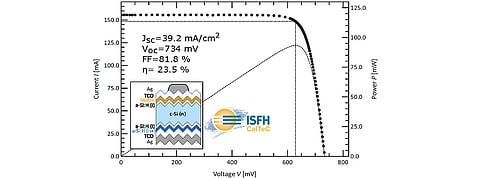

Researchers at the Swiss École Polytechnique Fédérale de Lausanne (EPFL) have reported 23.5% efficiency for a silicon heterojunction (HJT) solar cell while using molybdenum oxide (MoOx) as hole selective contact. The findings have been published in Nano Energy available on the website of ScienceDirect.
Silicon HJT cells face the challenge of parasitic light absorption in the amorphous silicon layers, but replacing traditional doped amorphous silicon selective layers with some other material can help deal with this problem.
For their research, the team prepared a silicon HJT structure using molybdenum oxide (MoO ) as a front-side hole selective layer. That means the a-Si:H(p+) layer from the typical silicon HJT structure is replaced with ultra thin MoOx film on the emitter side, while the rest of the structure remains the same. The research paper shows the influence of MoO and intrinsic a-Si:H thicknesses on current-voltage properties. The teams also disused mechanisms behind the carrier transport and performance-loss, which has remained elusive so far.
"In particular, we find that thinning down the MoOx and (i)a-Si:H layers (down to 4 nm and 6 nm respectively) mitigates parasitic sub-bandgap MoOx optical absorption and drastically enhances charge transport, while still providing excellent passivation and selectivity," explains the team. "High-resolution transmission microscopy reveals that such thin MoOx layer remains continuous and, while slightly sub-stoechiometric, exhibits a chemistry close to MoO3."
According to the team, their results indicated 23.5% certified efficiency for the screen-printed device with a fill factor of 81.8%, which helps bridge the gap with traditional Si-based contacts. It also shows that dopant-free selective contacts can rival traditional approaches.
The world record for a silicon HJT cell is 26.6% since 2017 and is being held by Kaneka from Japan (see TaiyangNews Heterojunction Cell Technology Report 2019).
.png?w=50&fm=png)